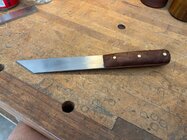I would think turning the back end of these tools into detail spindle gouges could be a great choice. Flute depth is much shallower and would be easier to grind. Additionally, adding this to your bowl gouge you could have a tool that would more than likely stay in it's tool rack in use with the detail side. If course there are also many tool shapes that could be ground on these round bars that don't even require a flute.I do the same and can confirm that both Thompson and D-Way tools are heat treated the full length of the tool.
I have ground a second flute into the tang ends of both Thompson and D-Way gouges. The 2nd flute doesn't need to be very long as CBN wheels grind so little steel away compared to the old style sparky wheels.
Besides giving you the option of having two different bevel angles on the one bar, an additional benefit of doing this is that you can grind whatever other flute profile you fancy into the 2nd end... :~}
This thread is a companion to one that I have added to the main discussion forum. This one is how I went about it while the other one covers the background and the results of my efforts. That other thread in the main discussion forum is titled DIY bowl gouges and flutes.
Prior to now the method I used to adjust flute profiles was to use diamond burs in my Dremel, but I have recently adopted fellow forum member Hughie’s method of using a thin cut-off wheel on my angle grinder to begin making a flute to make a new bowl gouge.
Initially I fixed the gouge down and handheld the...
- Neil S
- Replies: 6
- Forum: Tutorials and Tips
Gregory


